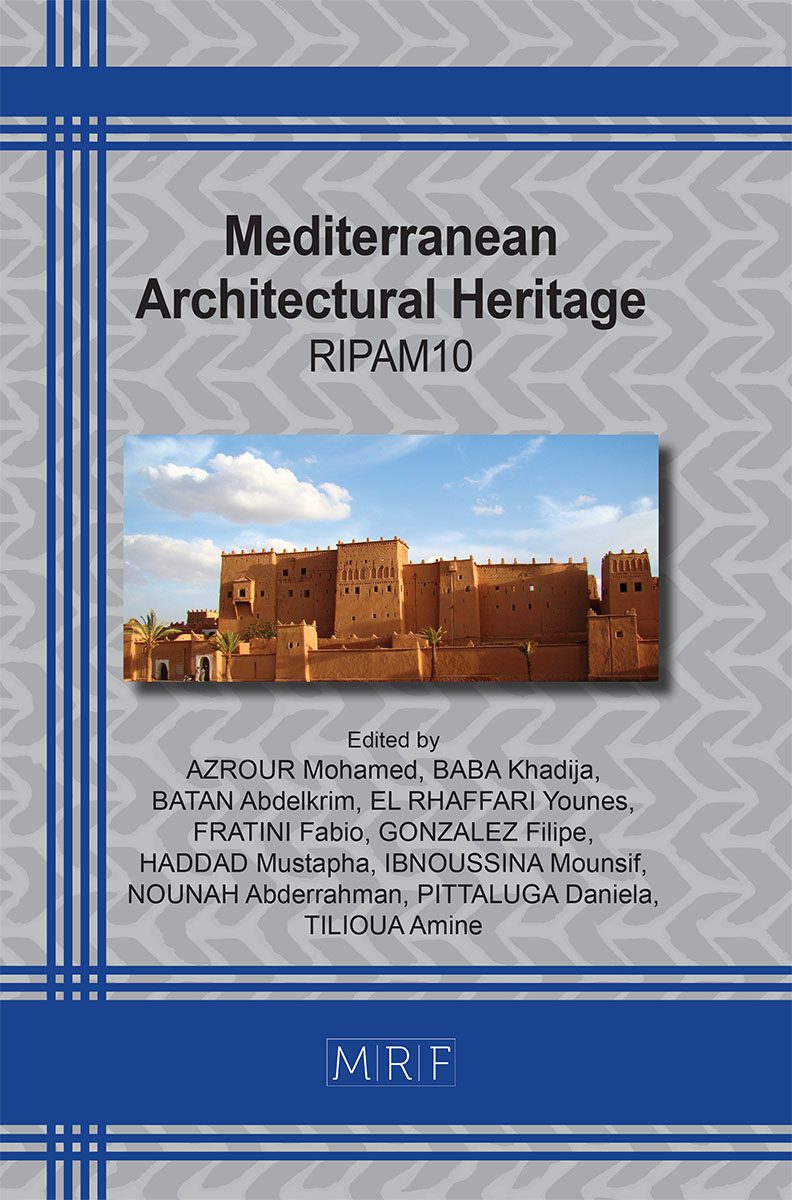Naturally Strengthening Rammed Earth: The Promising Potential of Biopolymers
Ilham MASROUR, Khadija BABA, Sana SIMOU
download PDFAbstract. Sustainable construction has become a global imperative due to the growing awareness of the harmful environmental impacts of the construction industry. The use of cement and lime in traditional methods of stabilizing earth constructions is a significant problem due to their high carbon footprint. This article examines an ecological alternative to stabilizing earth structures with biopolymers. These Bio-based materials can be used to reduce the environmental impact of the construction industry while also ensuring the structure’s stability and durability. The purpose of this article is to examine the mechanical properties of biopolymers in the context of stabilizing earth construction. The objective is to guide the decision on which stabilization method to use for earth construction based on the available resources.
Keywords
Earthen Constructions, Biopolymer, Compression Strength, Stabilizing Earthen Constructions
Published online 3/15/2024, 7 pages
Copyright © 2024 by the author(s)
Published under license by Materials Research Forum LLC., Millersville PA, USA
Citation: Ilham MASROUR, Khadija BABA, Sana SIMOU, Naturally Strengthening Rammed Earth: The Promising Potential of Biopolymers, Materials Research Proceedings, Vol. 40, pp 233-239, 2024
DOI: https://doi.org/10.21741/9781644903117-25
The article was published as article 25 of the book Mediterranean Architectural Heritage
![]() Content from this work may be used under the terms of the Creative Commons Attribution 3.0 license. Any further distribution of this work must maintain attribution to the author(s) and the title of the work, journal citation and DOI.
Content from this work may be used under the terms of the Creative Commons Attribution 3.0 license. Any further distribution of this work must maintain attribution to the author(s) and the title of the work, journal citation and DOI.
References
[1] F. Jové-Sandoval, M.M. Barbero-Barrera, N. Flores Medina, Assessment of the mechanical performance of three varieties of pine needles as natural reinforcement of adobe, Constr. Build. Mater. 187 (2018) 205–213. https://doi.org/10.1016/j.conbuildmat.2018.07.187
[2] T. Graham, Wattle and Daub: Craft, Conservation and Wiltshire Case Study, (n.d.).
[3] P. Silva, J. Pinto, H. Varum, D. Cruz, D. Sousa, P. Morais, P. Tavares, J. Louzada, P. Silva, J. Vieira, Characterization of Traditional Tabique Constructions in Douro North Valley Region, WSEAS Trans. Environ. Dev. 6 (2010) 105–114.
[4] E. Quagliarini, A. Stazi, E. Pasqualini, E. Fratalocchi, Cob Construction in Italy: Some Lessons from the Past, Sustainability 2 (2010) 3291–3308. https://doi.org/10.3390/su2103291.
[5] Mechanical properties of adobe walls in a Roman Republican domus at Suasa – ScienceDirect, (n.d.). https://www.sciencedirect.com/science/article/abs/pii/S1296207409001046 (accessed February 4, 2024).
[6] C.D.F. Rogers, I.J. Smalley, The adobe reaction and the use of loess mud in construction, Eng. Geol. 40 (1995) 137–138. https://doi.org/10.1016/0013-7952(95)00064-X
[7] J. Vargas, J. Bariola, M. Blondet, P.K. Mehta, Seismic strength of adobe masonry, Mater. Struct. 19 (1986) 253–258.
[8] E. Quagliarini, S. Lenci, The influence of natural stabilizers and natural fibres on the mechanical properties of ancient Roman adobe bricks, J. Cult. Herit. 11 (2010) 309–314. https://doi.org/10.1016/j.culher.2009.11.012
[9] F. Pacheco-Torgal, S. Jalali, Earth construction: Lessons from the past for future eco-efficient construction, Constr. Build. Mater. 29 (2012) 512–519. https://doi.org/10.1016/j.conbuildmat.2011.10.054
[10] Efficiency of cement and lime in stabilizing the black cotton soil – ScienceDirect, (n.d.). https://www.sciencedirect.com.eressources.imist.ma/science/article/pii/S2214785322049197 (accessed November 17, 2023).
[11] A.A. Disu, P.K. Kolay, A Critical Appraisal of Soil Stabilization Using Geopolymers: The Past, Present and Future, Int. J. Geosynth. Ground Eng. 7 (2021) 23. https://doi.org/10.1007/s40891-021-00267-w
[12] Stabilisation naturelle pour la construction en terre : argiles et biopolymères, amàco (n.d.). https://amaco.org/publication/publication-stabilisation-naturelle-pour-la-construction-en-terre-argiles-et-biopolymeres/ (accessed November 17, 2023).
[13] A. Vissac, A. Bourgès, D. Gandreau, R. Anger, L. Fontaine, argiles & biopolymères – les stabilisants naturels pour la construction en terre, (n.d.).
[14] Y. Sun, X. Ma, H. Hu, Marine Polysaccharides as a Versatile Biomass for the Construction of Nano Drug Delivery Systems, Mar. Drugs 19 (2021) 345. https://doi.org/10.3390/md19060345
[15] T. Ribeiro, D.V. Oliveira, S. Bracci, The Use of Contact Sponge Method to Measure Water Absorption in Earthen Heritage Treated with Water Repellents, Int. J. Archit. Herit. 16 (2022) 85–96. https://doi.org/10.1080/15583058.2020.1751344
[16] R. Aguilar, J. Nakamatsu, E. Ramírez, M. Elgegren, J. Ayarza, S. Kim, M.A. Pando, L. Ortega-San-Martin, The potential use of chitosan as a biopolymer additive for enhanced mechanical properties and water resistance of earthen construction, Constr. Build. Mater. 114 (2016) 625–637. https://doi.org/10.1016/j.conbuildmat.2016.03.218
[17] J.L. Parracha, A.S. Pereira, R. Velez Da Silva, N. Almeida, P. Faria, Efficacy of iron-based bioproducts as surface biotreatment for earth-based plastering mortars, J. Clean. Prod. 237 (2019) 117803. https://doi.org/10.1016/j.jclepro.2019.117803
[18] C. Cocozza, A. Parente, C. Zaccone, C. Mininni, P. Santamaria, T. Miano, Comparative management of offshore posidonia residues: Composting vs. energy recovery, Waste Manag. 31 (2011) 78–84. https://doi.org/10.1016/j.wasman.2010.08.016
[19] A.E. Losini, A.C. Grillet, M. Bellotto, M. Woloszyn, G. Dotelli, Natural additives and biopolymers for raw earth construction stabilization – a review, Constr. Build. Mater. 304 (2021) 124507. https://doi.org/10.1016/j.conbuildmat.2021.124507
[20] R. Anger, L. Fontaine, Bâtir en terre: du grain de sable à l’architecture, 2009.
[21] C. Galán-Marín, C. Rivera-Gómez, J. Petric, Clay-based composite stabilized with natural polymer and fibre, Constr. Build. Mater. 24 (2010) 1462–1468. https://doi.org/10.1016/j.conbuildmat.2010.01.008
[22] Y. Trambitski, O. Kizinievič, F. Gaspar, V. Kizinievič, J.F.A. Valente, Eco-friendly unfired clay materials modified by natural polysaccharides, Constr. Build. Mater. 400 (2023) 132783. https://doi.org/10.1016/j.conbuildmat.2023.132783
[23] C. Mileto, F. Vegas, L. García Soriano, V. Cristini, eds., Compressive strength of blood stabilized earthen architecture, in: Earthen Archit. Past Present Future, 0 ed., CRC Press, 2014: pp. 233–236. https://doi.org/10.1201/b17392-40
[24] Y. Millogo, J.-E. Aubert, A.D. Séré, A. Fabbri, J.-C. Morel, Earth blocks stabilized by cow-dung, Mater. Struct. 49 (2016) 4583–4594. https://doi.org/10.1617/s11527-016-0808-6































